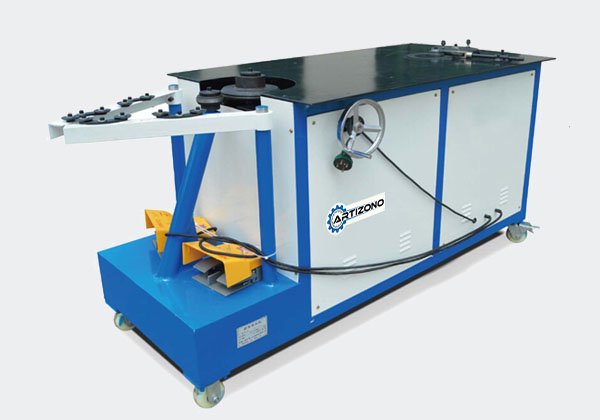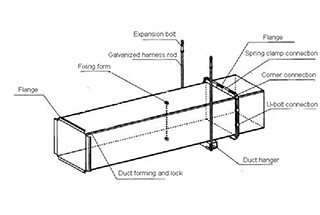
Have you ever wondered how those massive air ducts in buildings are made? This article dives into the fascinating world of spiral duct machines. These machines are crucial for creating efficient and durable ventilation systems used in various settings, from military applications to everyday buildings. You’ll learn about the machine’s features, the materials used, and the benefits of spiral ducts over traditional designs. By the end, you’ll have a clear understanding of why spiral duct machines are indispensable in modern HVAC systems.

Note:
If you want to purchase a spiral duct machine, you can check out the details here.

First, let’s examine what a Spiral Duct Machine is.
The Spiral Duct Machine is utilized to manufacture spiral air ducts.
It has applications in several military industries, as well as in the production of ventilation pipes and exhaust pipes for trains and subways in our daily lives.
The main purpose of the machine is to facilitate air circulation between two places, serving as a means of ventilation.

The Spiral Duct, with its high quality, operates quietly without any significant noise, water leakage, or air leakage. Additionally, it exhibits excellent resistance to corrosion.
The Spiral Duct Machine was initially developed and produced in Switzerland. Other nations relied on imports for a time, but with the introduction of advanced technology, many countries, including China, have begun to develop their own Spiral Duct Machines.
There are many reliable spiral duct machine manufacturers, Artizono is one of them.
The Spiral Duct is currently the most widely utilized air duct on the market.
Statistics show that the use of Spiral Ducts in office buildings, shopping malls, and subways in the United States stands at 95.6%, while the use of Spiral Ducts for central air-conditioning in residential buildings is at 72.5%.
The Spiral Duct is typically coated with a layer of zinc on the iron duct to protect it. The innovative spiral pressing rib technology provides the Spiral Duct with excellent strength to withstand pressure.
After the addition of the spiral rib, the thickness of the lock seam is four times that of the tube, resulting in a highly rigid pipe that can withstand maximum pressure without any damage. Additionally, the material thickness can be reduced by 15%, leading to a reduction in cost.
Spiral Ducts were first introduced in military industries in Western countries, such as in warship and ship exhaust (air supply) systems, before being adopted in civilian facilities like trains, subways, and mines.

The Spiral Duct Machine is a high-end round tube processing equipment.
Compared to other round tube manufacturing equipment, this machine boasts the qualities of versatility and flexibility, and is capable of processing circular tubes with diameters ranging from Φ80mm to 1500mm.
It is simple to adjust and does not require a fixed die. The length of the round tube can be set as desired, and the cutting is performed automatically by a saw.
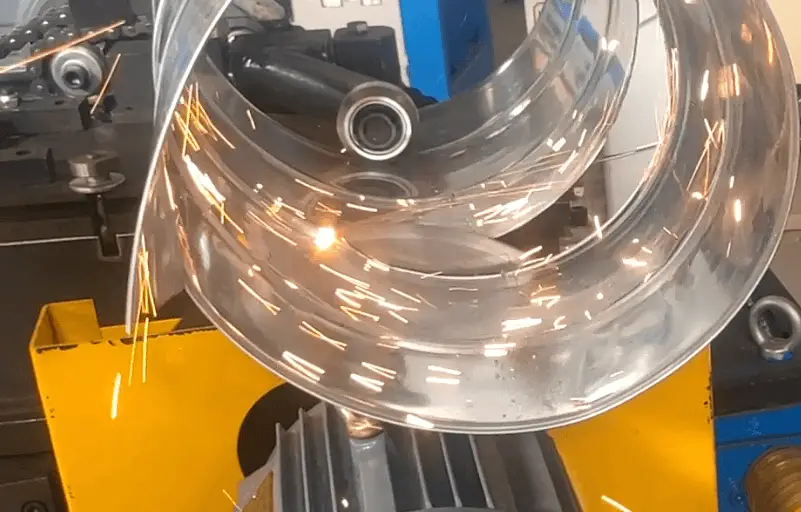
The Spiral Duct Machine is controlled by a PLC program and operated through a touchscreen interface. The main machine can be frequency-modulated and has a stepless speed control feature.
The linear motion is achieved through pneumatic means, and the sealing pressure is created through gas-liquid pressurization (the pressing force can be adjusted from 6-12MPa). All linear motions feature adjustable speed and pressure regulation.
Now, let’s delve into the features of the Spiral Duct.
Iron sheets are prone to chemical reactions in various environments, leading to corrosion and rust. On the other hand, zinc is relatively stable in dry air and forms a dense zinc carbonate film on its surface in moist air.
To protect the iron sheet, the Spiral Duct is mainly coated with a layer of zinc. After undergoing passivation treatment and photoresist coating, the zinc coating significantly improves its protection and appearance.
Compared to the traditional white iron pipe that is hand-knocked, the spiral duct made by a spiral duct machine has the following advantages:

Instructions for Installing a Spiral Duct Machine:
The Spiral Duct Machine features touch screen operation control.
Below is an introduction to the touch screen operator interface and buttons:

Touch screen operation interface diagram
(1) Manual/Auto:
(2) High speed: The machine will continuously run at high speed in manual mode.
(3) Low speed: The machine will continuously run at low speed in manual mode.
(4) Forward/Reverse: In manual mode, the machine generates slow forward and reverse motion in jog mode.
(5) Compression: Controls the compression and release of the upper seaming wheel.
(6) Cutting: Press this button to initiate a single cycle cut.
(7) Time setting: Press the “System Maintenance” button to open a page to set the time interval for the next automatic cycle after the end of the current one. The time unit is in seconds.
(8) Start: To avoid misoperation, press this button twice in the natural state. The Spiral Duct Machine will start in an automatic reciprocating cycle. Press the button again to stop the machine.
(9) Jog: Press and hold this button to run the machine in slow forward and reverse direction.
(10) Emergency stop: Press the emergency stop switch in case of an abnormal situation.
(11) Speed regulation: Adjust the frequency of the inverter for stepless variable speed control.
(12) Footswitch: In manual mode, it works in jog mode and can cut off power and stop the Spiral Duct Machine in automatic running mode.
(1) Install a 137mm wide steel strip on the loading rack and adjust the tail-rack so that the round tube diameter is matched. Apply normal motor oil to the oil wheel at the material feeding inlet.
(2) Mount the steel strip mold on the mold base based on the diameter of the pipe. Verify that the lower joint wheel matches the strip thickness. There are 4 matching seam wheels available, depending on the strip thickness.
(3) Insert the strip into the feed port and jog it through the four rolls and the platen to the upper and lower seam wheel. During this process, adjust the lock symmetry on both sides of the strip and the joint angle.
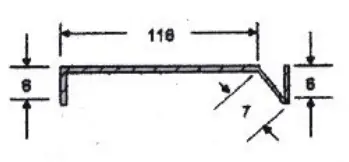 Adjust lock size |
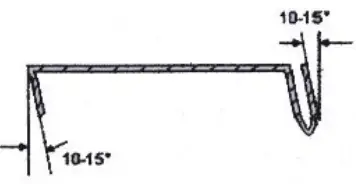 Seam angle |
(4) At a slow jog speed, turn the strip into a spiral tube shape in the mold, press the upper pressing wheel, and insert the wheel port into the female port. Slowly turn out a small section, then use the saw to flatten the mouth. Check the diameter of the tube and make fine adjustments if necessary.
(5) Transfer the nozzle to the discharge rack at slow or medium speed. Adjust the height of the discharge rack, the axial parallelism of the round tube, and the tube length and stroke switch.
(6) Repeat the adjustment process above until smooth transfer can be achieved after the first tube is made. Continued observation and adjustment may be necessary.
Mechanical Oil: Use 46# and refuel once every 8 hours of operation.
Grease: Refuel once every 40 hours of operation. The refueling points are all bearings and gears.
Every time you change the pipe size, it is necessary to remove any debris and iron filings from the corner gap. Ensure that you clean the area before beginning work and thoroughly wipe it down. If there is a prolonged period of inactivity, it is recommended to shut off the power, turn off the gas, and perform necessary oiling.
Electrical System
Touchscreen from Taiwan
Frequency converter: Common KEMRON
PLC: Japan Omron
The upper and lower rolls of the spiral duct machine are made of Gr15 steel, the quenching hardness reaches HRC58-62 degrees, and the belt mold is made of elastic steel.
The air pressure system of spiral duct machine consists of a compression cylinder, a return cylinder and a lifting cylinder.

The circuit diagram of the spiral duct machine can be found below.

Fig. Wiring Diagram of Spiral Duct Machine
You can also download the PDF file here. (in high definition)
(1) The installation of spiral ducts minimizes leakage at the joint points by reducing the number of connections between tubes.
Typically, spiral ducts are 3-6 meters in length, while rectangular ducts are only 1-1.5 meters. The connection of two spiral ducts requires just one joint, while connecting conventional rectangular ducts often necessitates a separate double flange system.
(2) Standardized products:
The production of spiral round duct fittings, including pipes and joints, is highly automated, systematic, and subject to industrial quality control.
(3) Low installation cost:
The installation time for a circular duct system is only one-third that of a similar rectangular duct.
(4) Minimal installation space required:
A circular pipe with a diameter of 200mm can replace a rectangular pipe of 250x150mm in the same installation space without increasing pressure. Multiple parallel circular pipes can replace flat rectangular pipes without requiring additional space.
When taking into account all of these factors, circular pipes generally occupy less space than rectangular pipes in most cases. For the same pressure characteristics, the installation space of several circular pipes is often equal to or less than that of a rectangular pipe.
Many rectangular piping systems require a 4-bolt system for installation, which adds 40-80mm to the pipe in all directions.
Low pressure:
It is well known that the wind resistance of a circular duct is much smaller than that of a rectangular duct.
Precision lock forming process:
The equipment utilizes molds made of specialized steel. Even after several years of use, the surface of the pressing mold remains unaltered, ensuring that the surface of the galvanized steel plate is not damaged. This prolongs the lifespan of the air duct and results in even seams, tight locks, strong connections, and excellent sealing properties.
Safety seal leakage prevention system.
The advanced spiral pressing rib technology enhances the strength of the spiral air duct to withstand pressure.
The addition of the spiral rib increases the thickness of the lock seam to four times that of the tube body, resulting in increased rigidity. The duct can withstand maximum pressure loads without deformation and reducing material thickness by 15%, thereby reducing costs.
In comparison, when the cross-sectional area is the same, the circumference of a rectangular duct with an aspect ratio of 1:3 is 40% longer than that of a spiral duct, making the latter a more efficient choice in terms of material usage. Similarly, the shorter circumference of the spiral duct allows for a corresponding reduction in insulation material.
Material used:
The material is commonly used galvanized iron strip (commonly known as star iron), stainless steel belt, soft aluminum belt.
Material thickness:
0.3 to 1.2 mm
Material width:
125 mm
Tube diameter:
φ125~φ1500mm (with appropriate diameter and thickness), stepless choice.

The spiral duct is a metal tube with thin walls, consisting of metal strips. It is circular in shape and does not require welding, resulting in no air or water leaks. It is utilized for the transportation of air and bulk materials, replacing traditional manual lock iron pipes. It is a type of air duct.
The main uses of spiral ducts are as follows:
(1) Air supply and ventilation:
This includes the provision of fresh air and exhaust, with a wide range of applications such as in factory workshops and production sites. The discharge of harmful gases and the influx of outdoor air into a room require the use of an air conveyance pipe with a high flow rate and low pressure, making the spiral air pipe an ideal solution. Usually, galvanized iron pipes are used, while stainless steel pipes are utilized in corrosive and highly humid environments.
(2) Cold air transportation:
The most common application is in central air conditioning pipes, which require insulation. The spiral duct can be covered with insulating material, resulting in a visually appealing appearance.
(3) Fume exhaust:
Restaurants and hotels generate large amounts of lampblack that need to be discharged. The circular duct serves as an oil chimney, also known as a lampblack tube.
(4) Dust removal:
Some factories produce significant amounts of dust in their workshops, requiring a specialized dust removal device. For pipelines with a high air flow, a spiral duct is an effective solution.
(5) Bulk material transportation:
In some factory production processes, it is necessary to transport loose particles, particularly those with a low specific gravity such as foamed plastic pellets. The use of spiral ducts is cost-effective and efficient for this purpose.
Since the spiral duct machine can only produce straight tubes, it has developed equipment such as elbow machines.
